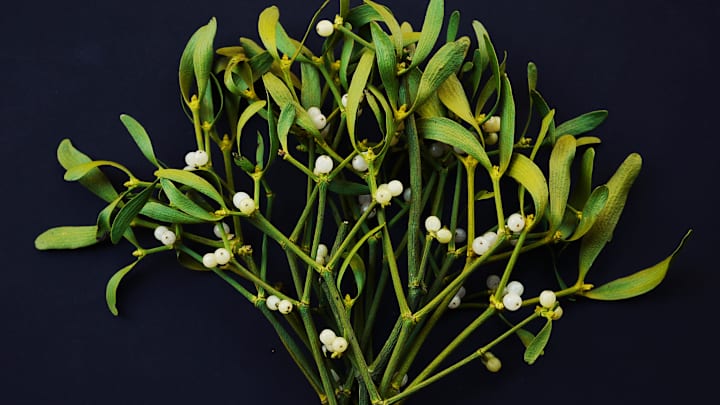Before someone asks to kiss you under the mistletoe this holiday season, arm yourself with these facts about the legendary plant—some of which aren't so romantic.
1. Mistletoe is a parasite.
The plant grows on trees, sucking up water and minerals from its host through a sinister-sounding bump called a haustorium. It might make you feel better to know that mistletoe is only partially parasitic: The plant is capable of photosynthesis, unlike true parasites that take all of their nutrients from their hosts.
2. Mistletoe has no fragrance.
Candle companies love to peddle holiday scents labeled “mistletoe.” You can even buy mistletoe-scented air fresheners for your car. But the actual plant, says mistletoe expert Jonathan Briggs, has no scent at all. Briggs, who hails from Gloucestershire, England, debunks all manner of mistletoe misinformation on his Mistletoe Diary blog.
3. Mistletoe has been used as medicine.

Over many centuries, mistletoe has been used to treat a battery of ailments, from leprosy, worms, and labor pains to high blood pressure. In Europe, injections of mistletoe extract are often prescribed as a complementary treatment for to reduce the side effects of chemotherapy in cancer patients.
4. Mistletoe hunting is a southern tradition.
Mistletoe typically grows in the highest branches of tall trees. Harvesting the bunches with a shotgun, to be sold as decorations during the holiday season, is a time-honored winter activity in the southern U.S. Let’s hope no one’s kissing under it at the time.
5. People once hung mistletoe over doors to keep ghosts away.
In the medieval era, mistletoe wasn’t just a Christmas decoration, but one perhaps better suited to Halloween. Hung over doors to homes and stables, it was thought to prevent witches and ghosts from entering.
6. The word mistletoe may be a reference to bird poop.

Mistletoe may be nod to the seeds’ ability to stick to tree branches when pooped out by birds. The unusual word might come from the Old English missel, which could refer to the mistle thrush, a bird thought to spread the seeds through its droppings; and the Proto-Germanic word for "twig." The viscous middle layer of the mistletoe fruit is so sticky that the seeds get glued where they land post-digestion, which starts a new mistletoe plant.
7. Druids revered mistletoe.
The Roman historian Pliny the Elder told how druids viewed mistletoe as sacred, recounting a ceremony where they gathered it with a golden sickle, then sacrificed two white bulls. The ceremony still takes place each year, minus the bull-slaying, at the Tenbury Mistletoe Festival in England.
8. In Norse mythology, mistletoe is like kryptonite.
Balder, the favorite son of chief god Odin and the goddess Frigg, was felled by an arrow made of mistletoe, the only substance that could harm him. Oddly, this may have been the origin of the kissing tradition. Some retellings of the story say that Frigg revived Balder and was so happy, she commanded anyone who stood under the mistletoe to kiss as a reminder of how love conquered death.
A version of this story was published in 2010; it has been updated for 2022.
